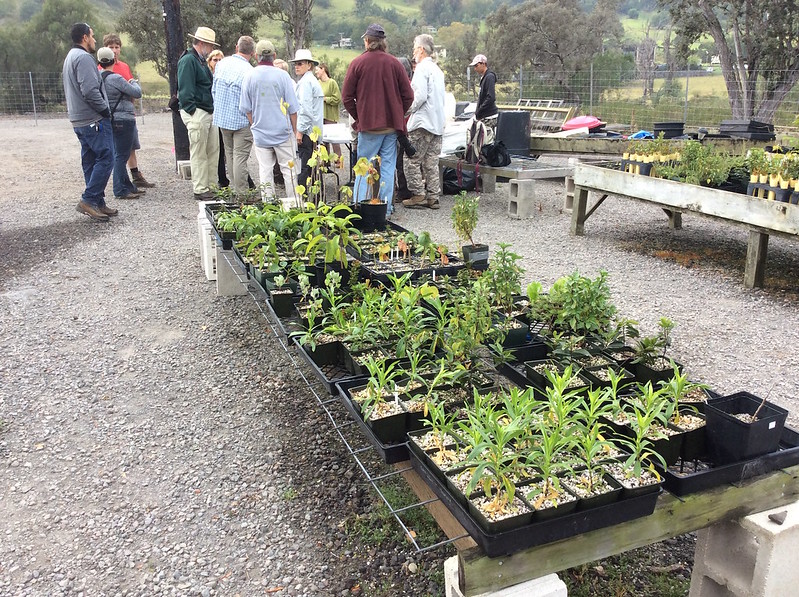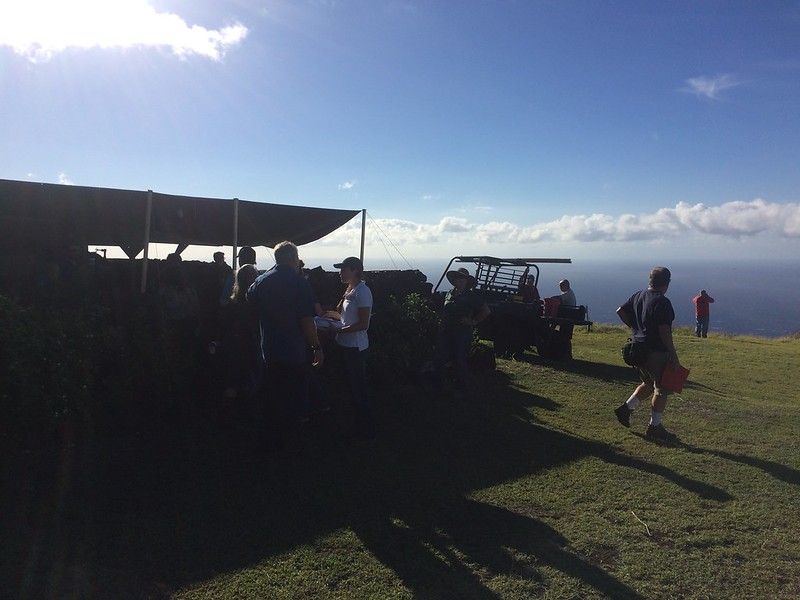Opening circle and prayer to begin the day.
Pacific Fire Exchange (PFX) and HWMO linked up on July 17 to hold an exciting day of fun and learning in Palehua, just mauka of Makakilo on Oʻahu. PFX’s Clay Trauernicht, Melissa Kunz, and Elizabeth Pickett spent several weeks planning this wildfire mitigation strategies workshop that led into a field tour as a follow-up to a workshop they put on at the PICCC conference several months ago. HMMO’s Pablo Beimler also joined the workshop as a helping hand. The Palehua workshop was tied into the Hawaiʻi Conservation Conference as a pre-conference event that interested conservationists could attend. Thirty or so people from various agencies and organizations including National Park Service, Honolulu Fire Department, Fed Fire, DLNR Division of Forestry and Wildlife, and University of Hawaiʻi joined the event.
The day kicked off with a workshop at Palehua Camp, formerly Camp Timberline, amongst tall trees and with scenic views of the Ewa area below. Clay Trauernicht gave a brief presentation on fire science using data he was synthesizing from the HWMO fire history database. Some interesting new factoids included:
* 75% of fires in Hawaiʻi are accidental
* 75% of fires in Hawaiʻi occur under drought conditions
* Over 80% of areas burned in Hawaiʻi are grassland/shrubland areas
Clay also shared about values at risk and their vulnerabilities. He adapted an equation he learned from a recent climate adaptation workshop, to fit into the fire science framework:
Vulnerability = exposure (fire hazards) + resource sensitivity (sensitivity to fire) — adaptive capacity (wildfire mitigation)
Elizabeth followed Clay’s presentation by highlighting various mitigation strategies. With these presentations in mind, the participants broke into groups for a computer-based activity. The groups picked a “designated mouse driver” and dug into the wildfire hazards and values at risk in Palehua using Google Earth. Once they determined areas of concern and the hazards that threatened those areas, they determined mitigation strategies they could apply to the area to reduce the fire hazard. They then shared their findings with the rest of the workshop participants. Anu and McD, two men who knew Palehua on the back of their hands, blessed us with examples of mitigation strategies they had actually implemented or planned to implement in the area.
Breaking out into groups to discuss wildfire mitigation strategies for Palehua.
Scanning through Google Earth to determine areas of concern and wildfire hazards in Palehua.
The workshop then shifted into a field tour as participants hopped into vans for the afternoon. The first stop was an overlook area where one could see where the 2014 Makakilo fire started and took off. The fire was an intense one that killed over 200 wiliwili trees and charred several homes. Mikiʻala Akiona, Public Education Specialist for Honolulu Fire Department, noted how difficult the fire was to suppress due to the many hot spots and restarts that occurred. The group then stopped towards the top of Palehua at a ranch-style building called Hokuloa, which had been used as a staging area and command center for large fires. Participants learned about the importance of having the right fittings for water tanks (as well as the need for suction hoses) and for creating fuelbreaks horizontal to the slope. Throughout this discussion, the participants had a spectacular view of central Oʻahu, which became increasingly obscured by a large rain cloud headed their way.
Looking out over the area where the Makakilo 2014 fire started.
Group photo in front of Nānakuli backdrop.
Rain cloud headed towards the group while looking towards Kunia.
Back of Nānakuli Valley where remnant native forests still exist.
The group then traveled up to a cabin for views of the north side of Palehua, where the discussion turned its focus toward the 2016 Nānakuli Fire that threatened homes and resources such as communication towers. The final stop added a little bit of adventure to the day. The participants hiked up to the top of Mauna Kapu through bamboo forests, stopping for a chant led by Anu before reaching the sacred peak. Once atop the mauna, Gary Gill, a large landowner in the area, gave background on how special the place they were surrounded by was. The area used to have one of the highest concentrations of native tree snails, but the population had been steadily declining within the last couple of years. There were several populations of different varieties of native birds still calling the area their home. Previous fires had burned ʻiliahi forests in the back of Nānakuli Valley, but about half of them had recovered, although they were much more stunted in growth than before.
The workshop and field tour was a memorable one for us all and we hope that the valuable lessons and conversations that took place were of value for all of the participants. Mahalo to all who came out for a special day in Palehua.














